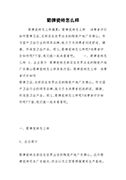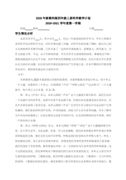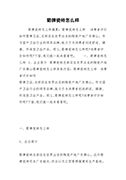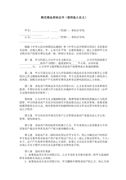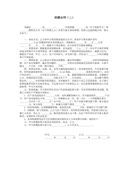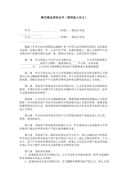《牛津小学英语》教学设计(精选13篇)四年级英语教案
《牛津小学英语》教学设计(精选13篇)
《牛津小学英语》教学设计 篇1
教学内容:《牛津小学英语》6b unit 3 asking the way a listen, read and say
教学目标:
1. 能正确地理解、掌握对话内容,并能初步朗读和表演对话。
2. 能正确地听、说、读词汇:miss, kilometre, away, only, city, road, far。
3. 掌握句型how far is it from here? it’s about a kilometre away。
教学重点:能正确理解、掌握对话内容,并能朗读、初步表演对话。
教学难点:能比较流畅地朗读对话,并能在掌握对话的基础上运用本课语言进行“问路”的对话交流。
教具准备:本单元的单词卡片、a部分挂图、磁带、录音机。
教学过程:
step1 warm up
1. listen to the song: excuse me
2. listen and do:
show me your left hand. / touch your right leg with your right hand. / stand up. / turn right. / turn left…
3. chant: where’s the bookshop?
4. look and say:快速出示单词卡,说出卡片上的单词,并拼读。
step2 presentation and practice
1. 出示本地区交通图,师生对话,引入本课话题。
t:mr smith is new here. he wants to visit hebing park. but he does not know the way. who can tell him how far is it from here? how to get there?
s:it’s about three kilometre away.
he can take bus no.4
t:how many stops are there?
s:there are two stops.
2. 板书对话中出现的新授句型并讲解,领读。
3. 分段呈现a部分内容,引导学生学习。
①学习第一段背景介绍。
a. 出示问题:
where does mr smith come from?
where is he living now?
what does he want to do?
does he know the way?
what is he doing now?
b. 听录音回答问题。
c. 跟读背景介绍部分的内容。
d. 齐读、个别读。
②学习课文对话的第一部分(从开始至页底),就对话场景提问,引导学生进入对话情景。
a. can you tell me the way to the history museum?
b. how far is it from here?
c. how many stops are there?
(教学程序同背景介绍)
③学习对话教学的第二部分。
本部分重点围绕询问车站在哪里。可通过听录音请学生回答where’s the bus stop?引导学生学习,学习方法同上。
注意帮助学生理解every five minutes的意思,如出示一个当地某公交车的发车时间表等。
④学习对话教学的第三部分。(从i want to go to the city post office, too.至结尾。)
就对话提出问题:
a. where else does mr smith want to go?
b. where is it?
c. how can he get there?
重点训练句型:you can take bus…and get off at the…stop.
4. 学生整体听读课文,利用挂图进一步理解对话内容。
5. 强调重点句型,分段表演对话朗读。
6. 在学生充分理解课文的基础上,指导学生完成对话后的练习。
step3 consolidation
教师在黑板上画交通图,根据图意同位看图编一段小对话“asking the way”并试着表演。
step4 homework
1. 听录音,用正确的语音语调朗读本课对话。
2. 同位练习表演问路。
板书内容:unit 3 asking the way
questions:1. can you tell me the way to the history museum?
2. how far is it from here?
3. how many stops are there?
4. where’s the bus stop?
5. where else does mr smith want to go?
6. where is it?
7. how can he get there?
板书设计:
《牛津小学英语》教学设计 篇2
unit 2 more exercise
连云港市赣榆县青口中心小学 范文艳
单元教材分析:
本单元引入了副词比较级。话题围绕着jim和他爸爸谈论如何进行体育锻炼展开,课前教师可设计一个学生自己制定锻炼身体的计划的任务,使学生把所学的语言知识与生活实际联系起来,有些副词的比较意义较为抽象,如late, later, early, earlier, well, better,建议教师在教学中尽可能地用具体的手段帮助学生理解这一难点。
教学要求:
1、能听懂、会说、会读和会拼写单词strong, slow, low, fish, late及be good at。
2、能听懂、会说和会读单词和词组far, well, jog, do well in, need help with, do more exercise, animal show, go for a walk。
3、能听得懂、会说和会读日常交际用语that’s true. well done. mike runs as fast as ben.
4、能听得懂、会说、会读、会写句型ben runs faster than jim. do the boys jump higher than the girls? does jim swim slower than david?
5、了解字母组合or在单词中的另一种读音。
6、会诵读歌谣run, rabbit, run!
教学重难点:
1、能听懂、会说、会读和会拼写单词strong, slow, low, fish, late及be good at。
2、能听得懂、会说、会读、会写句型ben runs faster than jim. do the boys jump higher than the girls? does jim swim slower than david?
教具准备:
录音机、小黑板、表格、图字卡、幻灯片、计时器、小星星若干、图片、红线、纸袋偶、跳绳。
课时分配:
第一课时 b部分 look, read and learn
第二课时 c部分 work in pairs
第三课时 a部分 listen, read and say
第四课时 d部分 listen and write和h 部分 say a rhyme
第五课时 e部分 look, read and judge, f部分 play a game
和g部分 listen and repeat
第六课时:综合实践课
友情提示:
1、学习本课之前先了解一下本班学生的身体情况及体育成绩,如谁跑得比较快,谁跳得比较高,以便在讨论话题时,让学生产生认同感和亲切感。
2、本单元渗及的比较级有两种形式:①动词+副词比较级+than;②as+副词原形+as及否定形式not as…as,与第一单元相似,不同的是副词比较级。
3、注意强调陈述句中,主语是第三人称单数时,动词加s或es,但在问句里,用助动词do或does,后面动词都用原形。
4、在语言训练过程中要注意由易到难,由浅入深,使学生保持浓厚的学习兴趣,让他们轻松愉快地学英语。对于个别学习上有困难的学生,要教给他们有效的学习方法,帮助他们养成良好的学习习惯。
4、四会单词及四会句型最好当堂掌握,并注意巩固,使每一个学生都能牢固掌握基础性知识。
5、在教学中要根据学生的实际情况,给学生留有自主学习和记忆的空间。
《牛津小学英语》教学设计 篇3
一 教学内容:《义务教育课程标准实验教科书 牛津小学英语》3b第三单元第一课时。
二 教学目标:
1 能正确听说运用词汇 grandfather, father, uncle, son, brother,
grandmother, mother, aunt, daughter, sister。
2 能较熟练地在情景中运用句型who’s he/she? he’s/she’s….
3 能正确区别he和she。
三 教学重点:
1 能够正确听说运用家庭成员类单词。
2 能运用who’s he/she? he’s/she’s….进行问答交流。
四 教学难点:
正确区别he和she。
五 课前准备:
1 制作与家庭成员类单词及句型有关的课件。
2 磁带,录音机。
六 教学过程:
(一) free talk:
1 师生之间用交流语进行问候。
a good morning/afternoon.
b hello! nice to meet you !
c how are you?
d are you happy today?
2 电脑出示实物(钟,小刀,故事书,收音机)通过“猜物”游戏与学生做问答练习,复习巩固上一单元内容,同时为新内容做铺垫。
t:look, what’s this?
s:is this/that a/an…?(教师点击图片,揭示正确答案。)
3 听音乐,渗透歌曲教学,以此来激发学生的兴趣。
listen to the music “family song”.
(二) presentanition and practice:
1 oh ,what’s this?(学生猜is this a…?)it’s a family photo.电脑出示全图和短语family photo,理解并领读。
2 教师以helen的身份出现
a i’m helen. this is my family photo.there are many people in my family .guess! who’s he?依次点击照片上的男性,教师引导学习。
点击父亲图片:who’s he? he’s my father.(学习father)
点击祖父图片: look at the old man. he’s my father’s father.who’s he?he’s my grandfather.( 学习grandfather)
点击叔叔图片: look at the man in the brown coat. he’s my father’s brother.(学习brother) who’s he? he’s my uncle.( 学习uncle)
点击mike图片look at the boy. he’s my brother. he’s my father’s son.(学习son)
出示所有男士图片,与学生进行交流问答,领读who’s he?并理解he,用he’s….造句介绍自己身边的同学。
学生利用自己的照片,对照片上的男士进行对话练习并表演。who’s he?he’s….
b 同法学习mother,grandfather,aunt,daughter,sister.
点击母亲图片: who’s she? she’s my mother.(学习mother)
点击祖母图片: look at the old woman. she’s my father’s mother. who’s she?she’s my grandmother.( 学习grandmother)
点击阿姨图片: look at the woman in the blue coat. she’s my mother’s sister.(学习sister) who’s she? she’s my aunt.( 学习aunt)
点击helen图片: look at the girl. she’s mike’s sister. she’s my father’s daughter.(学习daughter)it’s me.
出示所有女性图片,与学生进行交流问答,领读who’s she?并理解she,用she’s….造句介绍自己身边的同学。
学生利用自己的照片,对照片上的女士进行对话练习并表演。who’s she?she’s….
c 教师总结 this is a big family.they are all very friendly. do you want to make friends with them?出示friend,领读并理解。用he’….和she’s….介绍自己的朋友。
(三)play a game:(通过游戏复习所学单词及短语)
在教师的叙述中猜猜他或她是谁,比比谁最快。
your uncle’father is….
your aunt’s mother is….
your mother’s son is….
your mother’s sister is….
学生模仿老师进行叙述,继续游戏。
(四)work in pairs:(三人一组。模仿家庭人物进行表演。)
a: who’s he/she?
b: he’s/she’s….
c: nice to meet you!
(五)homework:
1听录音读听单词。
2用所学句型介绍自己的全家福照片。
3 欣赏歌曲“family song”。
《牛津小学英语》教学设计 篇4
课前准备
1.多媒体课件。
2.上课所需的食品及饮料。
3.本课单词卡片及句型挂图等。
教学过程
1.warming up
[设计理念】课前的热身活动已经成了英语课的必要步骤,目的是集中精力,把学生的思想和情绪转到学习英语上来。教师可设计说一说、唱一唱、猜一猜等环节来促使学生能够快速地进入“角色”,全身心地做好学习英语的准备。
2.t:(多媒体出示星星、月亮图片)hello,boys
and girls.
ss:hello,miss cao.
t:look at the picture.what’s the time in the
evening?
ss:it’s 8:45.
t:shall we do the puzzle/watchtv,now?
ss:no.it’s time to go to bed.
t:yes.it’s 8:45 in the evening.let’s go tobed.ok?
ss:ok.
t:(做出趴在桌上睡觉的姿势,并以此引导学生跟着“睡觉”)now let’s sleep on the desk.
ss:(sleeping.)
3.t:(启动闹钟响:“起床啦!起床啦!”)0h,i’m sorry.boys and girls.it’s time to get up.get upboys and girls.
ss:all right.
t:(多媒体出示早晨6:30太阳升起时的图片)what’s the time in the morning?
si:it’s 6:30 in the morning.i’m hungry.1want to have breakfast.
who can help me?(出示hungry单词图片)
s1:(在老师引导下做出相应回答)here’s a
cake/hamburger/sandwich…for you.
t:thank you.
ss:not at a11.
t—s(2—3组)
t:now,who can read this word?(手举“hungry”单词卡片)
引出教学及拼写该单词。
【设计理念]一是利用旧知引出新知,使学生在原有知识的基础上产生正迁移。二是“入境始与亲”,利用多媒体为学生、为课堂创设情境。这样,一方面避免了教师与学生、学生与学生之间单调、抽象、乏味的口头交流,取而代之的是生动、直观、形象的视觉效果,从而更好地培养了他们说英语的能力。另一方面,由此带来的效果会使学生对学习产生好奇感,从而大大提高学习的积极性。
t—s do action(手摸肚子,并做揉状)and say:i’m hungry.
t:excuse me.i’m hungry.are you hungry?
si:yes,i’m hungry.
t:here’s a…for you.
s1:thank you.
t—s(2组)
(引导学生问老师)si:are you hungry?
t:n0,i’m not hungry.i’m thirsty.(出示“thirsty”单词图片,并用手摸喉咙,咳嗽几声表示口渴)
s:here’s…for you.
s—t(2组)引出“thirsty”,并对其进行拼写教学。
t:excuse me.i’in thirsty.are you thirsty?
si:yes,i’m thirsty.
t:here’s a…for you.
s1:thank you.
t—s(2组) s—t(2组)
[设计理念】“体态语”是小学英语教学中的辅助教学方式之一,它形象、生动,能帮助学生理解课文内容,还可活跃课堂气氛,查看更多文章请访问小学课堂网增强学生学习英语的兴趣和求知欲,从而提高课堂教学质量。
准确、恰当地运用体态语,将会对整个课堂教学起到“此时无声胜有声”的效果。
t:excuse me,i’m hungry.are you hungry?
s:no.i’m not hungry.
t:what’s the matter?(出示“what’s the mat—ter?”的中英文卡片)
(在老师引导下做出回答)ss:i’m thirsty.
t:ok.here’s a…for you.
s:thank you.
t—s(2~3组)
教学该句型:matter,matter.what’s the mat‘
ter?
ss read one by one.
[设计理念】对本课的重点句型“what’s the
matter?,’进行分解教学——先教单词“matter'’,再
教句型“what’s the matter?”。这种循序渐进的教
学方法,消除了学生学习新句型前的紧张心理。
t:excuse me,s1.what’s the matter?
si:i’m hungry/thirsty.
t:here’s a…for you.
s1:thank you.
t—s(2~3组)
s1:what’s the matter,miss cao?
t:i’m hungry.
s1:here’s a…for you.
t:thank you.
s2:what’s the matter?
t:i’m thirsty.
s2:here’s a…for you.
t:no.1 want to drink some water.
在老师引导下,s2拿水(冷水)走上前给老师
喝。
t:thank you.
t:(喝水)oh,it’s too cold.(出示“cold”单词
卡片,同时,老师用手捂着嘴,表示水很凉。走到
学生跟前,将同样的水递给学生喝)t:drink the
water,please.
s1:thank you.
(在生喝完水后)t:what’s the matter?
s2:(跟着做,学着说)it’s cold.
t:oh.i see.
t—s(2组)
以此引出教学单词“cold”,并对其进行拼写教学。
[设计理念】课堂教学中,学生的切身体会如摸一摸、猜一猜、尝一尝等都是为课堂教学打出的一种最有效的“广告”。一方面,增强了学生的学习欲望。另一方面,由亲身体验得来的结果将会让人难忘。
ss say and d0 actions after t:边说“c-o_l—d。。ld”边用力搓手,一直到手发热。
t:oh,my hands are hot now.i’m hot.are youhot?(出示“hot”单词卡片)
(在老师引导下做出回答)s1:yes,i’m hot.
t:thank you.
t—s(2组)
引出并拼写教学“hot”。
4.t:n0w,please say and do after me.(利用多媒体出示)
matter。matter,what’s the matter?
hungry,hungry,i’m hungry.
thirsty,thirsty,i’m thirsty.
cold。cold,i’m cold.
hot,hot,i’m hot.
(重复多遍)
『设计理念]在教学过程中,适时地穿插一个小结.既能使学生缓解因为长时间学习产生的疲劳感,又可让学生系统总结前半节课的内容,理清学习思路。这对正处于“乱如麻”思绪的小学生来说无疑是“锦上添花”。
5.t:exeuse me,what’s the matter?
si:i’m thirsty/hungry/cold/hot.
t:here’s a cup of tea/hamburger/coat/fan
for you.
s1:thank you.
t—s(2—3组)
t:now,let’s say a chant.
hungry。hungry,eat,eat,eat·
thirsty,thirsty,drink,drink,drink.
hot,hot,fan,fan,fan.
cold.cold,run,run,run.
(重复多遍)
t:oh.stop.please.i’m very tired now.what’sthe matter?
(出示“tired”单词卡片,并作出气喘吁吁的样子,表示很累。)
(在老师引导下做出回答)s1:i’m tired.
t—s(2—3组)
教学“tired”这个单词,并引导学生对其进行拼写。
t:now.we are all very tired.let’s have arest.ok?(示意学生坐在位置上休息片刻,并走到一学生面前)excese me,how are you now?
sl:i’m fine.
t—s(2组)
t:(出示一小男孩脱掉衣服后“ill”的图片)look。he is xiao hai.is he fine,too?
(在老师引导下做出回答)ss:no,he is i11.
引出并拼写教学单词“ill”。
t:excuse me,are you ill?
s1:yes。i’m i11./no,i’m not i11.
t—s(2组) s—t(2组)
6.t:now.1et’s say the new chant.
hungry,hungry,eat,eat,eat.
thirsty,thirsty,drink,drink,drink.
hot,hot,fan,fan,fan.
cold,cold,run,run,run.
tired,tired,sit,sit,sit.
ill,ill,go to bed.
(重复两遍)
【设计理念】说说、动动是孩子的天性。一首简单明了的歌谣(小诗),将本节课的生词全部包括在内,让孩子们在边说边做动作的过程中,记住这些原本相对他们来说比较难记的单词。对孩子们来说.这将是件乐此不彼的事情。另外,也舒缓了学生的疲劳感,活跃了课堂气氛。
7.t:now.1et’s play two guessing games.
(1)what’s missing?(老师挨个抽掉所贴的单词卡片,然后问学生:“what’s missing?”,生回答。对于回答对的学生,老师会把该生答对的那个单词卡片作为奖品发给他)
(2)where’s“hungry/thirsty”?(和游戏(1)相反,老师问“where’s‘hungry/thirsty’?”,手里有那张对应卡片的学生会说“it’s here”,然后上前把卡片重新贴到黑板上)
[设计理念]多样化的教学方式能让学生眼前一亮。猜谜游戏更是激发了学生的求知欲,活跃了课堂气氛,让学生在掌握原有歌谣(小诗)的基础上,更加牢固地记住这些单词。
8.t:excuse me.what’s the matter?
s1:i’m hungry/thirsty…
t:here’s a…for you.
s1:thank you.
t:that’s all right.
t—s(2组) s—t(2组)
9.t:(出示uunit 9 what’s the matter?课文的part c部分图片)now you can practice the sen-tences with these pictures with your partner.one is
the boy,and the other is the girl.
ss practice&act.
1 0.make a dialogue with your friends.
modle:
t:good morning.s1.
s1:good morning,miss cao.
t:it’s sunnv today.let’s go to the cinema,ok?
s1:au right.let’s go.
t:0h.i’m sorry.(手捂着肚子,皱着眉头,慢慢地弯下腰,表示肚子疼。)
s1:what’s the matter?
t:i’m i11.
si:let’s go to the hospital,ok?
t:en.. [设计理念]在课尾,安排一个拓展对话练习时间,是为了操练本课所学的单词和句子。另外,在学生的操练过程中,教师要善于启发学生把新旧内容串起来,在情境发展中适当地应用所学语言,让学生的个性在这里得到充分的张扬。
1 0.homework.
(1)copy the new words.
(2)make a new dialogue with your friends.
[设计理念]英语作业要巩固课内知识,还要引导学生开阔视野,让英语走进学生的生活。布置一些生活化的英语作业,让学生体会到自己是学习英语的主人,也让家长逐渐重视自己孩子的英语学习
《牛津小学英语》教学设计 篇5
教学内容:e. look, read and judge.补充练习a部分
教学目标:
1.能听懂、会说、认读单词centimeters。
2.通过观察、朗读、训练学生阅读理解语篇的能力,并能针对问题做出正确判断。
3.通过听力练习,提高学生观察思维及听的能力。
教学重点:能正确流利朗读阅读材料,并理解内容。
教学难点:
1.流利、规范朗读语言材料
2.正确完成听力
教具准备:录音机、磁带、图片、词卡等
step 1 warm up
1. greetings
2. sing a song: i wish i was taller!
3. free talk
利用室内现有物品及学生实际情况,围绕b.c部分的词.句及…as…as…句型与学生间灵活展开对话,以此检查学生对知识掌握情况:
step 2 revision
1. listen repeat and answer(a部分内容)
①on sunday morning. where did su hai go for a walk?
②who did she meat?
③what did they do under a big tree?
④do su yang and su hai look the same?
⑤is su hai as tall as su yang?
⑥who’s younger, su hai or su yang?
⑦does jack have any brothers or sisters?
⑧how old and is jack?
2. look and read
出示b部分图片比较,生说形容词及其比较级。
3.写出形容词的比较级
step 3 presentation
1.导读e部分引言部分,学习goal keeper。
2.生自由朗读。
3.学习165 centimeters。
出示指导朗读,并适当拓展。
4.指生读
5.指导生完成下面的判断
6.read and check
step 4 do exercise(练习册a部分)
1. look at the pictures and talk about them.(可让生同位间进行)
2.listen to the tape.(指导生记录关键词语)
3.listen and repeat.
4. listen and judge.
5. listen and check.
step 5 home work
1. read the text of part a.
2. read and write the words two times.(b部分)
板书内容:
词组:b部分的形容词及其比较级goalkeeper, centimeter
句型:…as…as…
…(比较级)than…
板书设计:
教后笔记:
《牛津小学英语》教学设计 篇6
unit 6 planning for the weekend
连云港市赣榆县实验小学 姜竹晓
单元教材分析:
本单元主要围绕“周末活动计划”这个话题开展各项活动,所涉及的日常交际项目有介绍、打电话、询问和建议等,其中以询问what are we going to do…?及we’re going to…为重点内容。
教学目标:
1、能听得懂、会说、会读和会拼写单词plan,picnic,play,take part in。
2、听懂、会说和会读单词project,zebra,africa,elephant,concert,outing,beijing opera show,singing contest,sports meeting。
3、能听得懂、会说、会读日常交际用语is that gao shan? yes, speaking. by the way,what are you going to do…?等。
4、能听得懂、会说、会读和会写句型what are we going to do…?we’re going to…
5、了解字母组合ow在单词中的读音。
6、能唱歌曲will you join me?
教学重难点:
1、能听得懂、会说、会读和会拼写单词plan,picnic,play,take part in。
2、能听得懂、会说、会读和会写句型what are we going to do…?we’re going to…
教具准备:课件(图片)、录音机、磁带、小黑板、投影片、教学挂图等。
课时安排:
第一课时:b look,read and learn c look and say
第二课时:a listen,read and say
第三课时:d listen and write
第四课时:e read and number
第五课时:f play a game
g listen and repeat
h sing a song
第六课时:综合练习课,完成补充习题。
友情提示:
1、本单元开始学习一般将来时,教师要讲清楚一般将来时的意义、构成和时间标志。
2、注意归纳总结at,on,in,with,for,of…的用法。
3、教师要讲清楚一些语法知识。例如,乐器类前加the ( play the piano ), 球类前不加the ( play football )。又如,介词的用法( for your class project, at the bus stop, at 10:30, look at, in the zoo, be from…, come home, in new york, with his friends, at the shopping centre, near their school, in front of the garden theatre, plans for the weekend, in the school…)。又如,名词复数的用法(buy some presents, buy some kites, see his parents…)。
《牛津小学英语》教学设计 篇7
the first period一、teaching contentsi. words:housework, ring, morning, home, help, maths, at home, sweep the floor, clean the windows, do housework, do homework, come and help…with…,ii. sentences what are you doing? i’m… what is he/she doing? he/she is…is that…? can you come and help..with…?二、teaching steps step1: greetings t: ok! it’s time for class. today i’m your english teacher. i’m miss feng. hello! boys and girls! ss: hello, miss feng! t: nice to meet you. ss: nice to meet you, too.step2: free talk (1) t: you know, i’m new here. so i want to know something about you. excuse me, may i have your name? s: i’m / my name is … t: nice to meet you. s: nice to meet you, too. t: oh, i am writing down your name.(教师记下该学生的名字,并且给他看)(2)t: excuse me, may i have your name?s: i’m /my name is… t: what is your telephone number? s:… t: i am writing down your telephone number.(3) t: excuse me, may i have your name? s: my name is… t: do you like english? s: yes, i do./ no, i don’t. t: do you like maths?s: yes, i do./ no, i don’t.t: look! this is a maths book. (教师出示一本数学书,拿出单词卡片maths,学生跟读单词) do you like maths? how about you? (复习已学句型)step3: presentation(1) t: now, i know something about you. do you want to know something zbout me? it can help you.(课件出现两个“风车”,风叶上写有关于教师的一些个人信息,学生根据这个向老师提问)s: what is your telephone number? what animals do you like? … what can you so?t: i can dance. look! i am dancing now. (教师一边做动作,一边说)(2) 学习新句型what are you doing? i’m…t: i can play baketball. (教师打篮球)can you play basketball? s: yes. t: can you show me ? ( 学生打篮球) s: oh, you are playing basketball.(3) t: can you play basketball? s: no, i can’t. t: what can you do?s: i can…s:学生做相应的动作(动作要有持久性) (4) t: what are you doing? s: i am sitting./ i’m having an english leaaon. (教师注意提醒学生动词后要加ing,并纠正读音)(5) t: what are you doing, boys and girls? s: we are having an english lesson. t: but where is my english book? i can’t find it. who can come and help me?(学生帮助老师找书) oh, there are some pictures here. you can choose one picture and do the action. (教师英语书里夹有一些图片,学生抽出一张并做相应的动作)t: what are you doing?s: i’m…(教师与学生示范对话→学生与学生示范→)(6) students use the pictures and make some dialogues with their partners. (7) 学习新句型 what is he/ she doing? he/she is…t: now, let’s have a rest and sing a song ‘what are you doing?’ then tell me what mike is doing? (学生看课件齐唱)(8) t: what is mike doing? what is he doing? (从歌曲中获知信息) s: he is sleeping. t: is he sleeping? (教师指向一个做得不端正的学生) s: no. t: what is he doing? s: he is sitting. t: how about that girl? what is she doing? s: she is… (教师呈现句子卡片what is he/she doing? he/she is…,学生跟读)(9) t: what is she doing? (教师在一个学生耳边说,单词,让该生做动作)s: she is… (学生问学生答)(10) look! it is saturday afternoon. what are my friends doing? what is wang fang doing? what is qianqiang doing? do you know? (让学生猜猜老师的朋友在做什么事,设置一定的悬念) s: no.t: i don't know either. but s1 knows. why? because there is a piece of paper in her hand. the answers are on the paper. let me call her. (教师拿出一个玩具电话,与该生打电话,教师与学生之间的对话为下面学生之间的交流,起到一个很好的示范作用)( 教师呈现打电话用语hello! is that…? yes, this is …speaking.)(11) t: let’s count the numbers and pass the paper. if miss feng says stop. you can call the student who gets the paper. (学生传递着有答案的那张纸,教师喊停,其他学生可以打电话给拿到该纸的学生,这个活动既有效巩固了句型what is he/she doing?又操练了电话用语)(12) t: oh, i know my friends are doing different things. how about su yang and su hai? what is su yang doing? (课件呈现苏扬在做什么的模糊图片) s: she is cleaning the windows. (学习词组clean the windows) t: clean the chair? can you make somne phrases?s: yes. clean the desk/ door…t: can you spell the word’door’? can you read this word?(课件呈现单词floor)同法教授新词组sweep the floort: su yang is cleaning the windows. su hai is sweeping the floor. what are they doing?(13) t: su yang and su hai are doing housework. suddenly, the telephine is ringing.(课件里有电话声音) listen! what are they talking about? let’s look, listen and judge. (14)多媒体呈现课文引言部分,学生跟着老师读(15) what is nancy doing? let’s listen againnames what is she doing?su hai is su yang nancy (16) 多媒体呈现课文左半边对话,学生跟着老师读,教师讲解新句子can you come and help me with my maths? (17) 学生自由读对话→学生表演对话(把全班学生分成两大组,分别扮演两个角色,背对背表演)step4: consolidationstep5: homework
《牛津小学英语》教学设计 篇8
一、教学内容 《牛津小学英语》5b第六单元 第二教时
二 教学目标
1、语言技能
⑴能熟练掌握本单元所学的体育课的口令。stand in … line(s) , please.\let’s do some exercise .\ turn left , turn right .\put your …on…\ touch your …with …\bend your …times.
⑵能比较熟练地在情景中运用单元所学的日常交际用语和口令去完成一项任务,即:会做小小的体育老师发命令,并会听口令做动作。
⑶能正确流畅地认读本单元出现的词句。
⑷通过小组合作学习,培养学生的合作意识,并在运用中提高他们的英语口头表达能力和交际能力。
2、学习策略
通过游戏,简笔画,形似词,让学生有意识地记忆、比较、认读单词。
3、情感目标
培养学生学习兴趣;能动手设计简单的运动操,有一定的创意。
三 教学重点
教学目标1、2、3。
四 教学难点
能正确使用和执行所学的口令。
五 课前准备
1\教具准备: 多媒体课件、口哨
2\板书准备: 黑板上预先写好标题 unit6 at a pe lesson.
六、教学过程
step 1 warming – up
1.introduce myself
2.freetalk
3 .sing a song and do some exercise.
teach : exercise / do some exercise
step2 presentation
1.teach: orders / give orders / follow the orders
the way :
t: boys and girls, today we will have a pe lesson. i’m your pe teacher . let’s do some exercise again, i give orders and you try to follow the orders.
b. drill: orders / give orders
c. play the game .
show me your hands
touch your hair / head /eyes /mouth /ears/ hands .
2. teach : left right
3 .teach : stop
4.teach : stand in a line
5. teach :turn left / turn right 转
the way :
a.接上步的游戏, 叫几个学生上去,师发命令学生做,并奖励。
t: now boys and girls . stand in …lines, please. let’s do some exercise.
show me your left hand .turn left .turn left .turn right .turn right.
b. drill: turn / turn left / turn right
c. t: i give orders and you try to follow the orders.
turn left /turn left / turn right one time / turn right two times
6.teach : time 次
practice : pair work
7. teach : bend
now boys and girls . stand in …lines, please. let’s do some exercise.
a. put your hands on your waist and turn left and right …times .
bend your arms…times.
b. drill :bend
b. practice:
师做生说短语 / ss give orders (并奖励stars .)
bend your legs / legs / arms
8.teach: up and down
step 3 drill
1.listen to the tape and answer .
where are they ?
what are they doing ?
how many orders have you hear ?
2 listen and repeat.
step 4 practice
1.orders:
stand in … line(s) , please. let’s do some exercise .
turn left , turn right . bend your …times.
put your …on… and turn left and right …times.
2.practise in pairs.
3.four group
4.check and pried
step 5 consolidation
1. game :i say , you do . i do , you say . (奖励)
2. sing :let’s do some exercise.
3. 四人组合一个队,用今天所学的指令编一套简单的运动操。
4.check and consolidation
teaching design
unit 6 at a pe lesson
stand in … line(s) , please.
let’s do some exercise .
turn left , turn right .
put your …on…
touch your …with …
bend your …times.
《牛津小学英语》5b/unit6 a pe lesson公开课 第二教时 来自98e范文网。
《牛津小学英语》教学设计 篇9
unit 1 who is younger?
单元教材分析:
本单元的主要话题是两种事物的比较,通过ben, jack和su hai之间的闲聊引出本单元的主要语言项目:形容词比较级。教师可创设情景,用实物或动作将比较级的概念清晰明了地传播给学生,同时注重比较级单词的读法与写法规律。
教学目标:
1.能听懂会说、会读、会写单词tall, young, old, heavy。
2、能听懂会说、会读单词和词组twin, minute, centimeter, child, also, chat。
3、能听懂会说、会读日常交际用语:i’m as tall as you. su yang’s twenty minutes younger than su hai. whose school bag is heavier, yours or mine?
4.能听懂、会说、会读、会写句型who’s taller then david? gao shan is taller than david。
5.了解字母组合or在单词中读音。
6.会唱歌曲i wish i was taller。
教学重点:
1.能掌握本单元的四会单词、句型。
2.灵活运用形容词的比较级于真实情景中。
教学难点:掌握形容词比较级的读写规律及用法。
教具准备:录音机.磁带.挂图.图片.相关的实物等。
课时安排:第一课时:b. look read and learn c. work in pairs
第二课时:a. listen, read and say
第三课时:c. work in pairs d. listen and write
第四课时:e. look, read and judge 练习册a部分
第五课时:f. play a game g. listen and repeat 练习册b部分
第六课时:h. sing a song 练习册c.d.e.f部分
友情提示:
1.注重各环节中的情景设计.本单元重点学生形容词及其比较级用法。教学中,教师在每个环节中都要注重对情景的设计。利用实物进行比较,让学生对比较级有直观清晰认识。另外本单元牵涉到人物的比较,教学中可联系学生实际进行语言交际,让学生在真实的交际中体会语言,学习语言。
2. 注重对语法知识的渗透讲解.学生刚接触比较级对其用法易模糊,特别对于“…than…”和“…as…as…”两句型易混淆,因此教学中教师有必要对学生对此句型进行简单梳理,讲清两句型特点及区别。(详细内容见教参)
3. 注意对“who’s(比较级)than…?”和“whose…is(比较级)?”两句型的区别讲解,在教学中学生对这两句型的构成易混淆,教师要注意在新授时帮助学生理清句式特点及句意。
《牛津小学英语》教学设计 篇10
教学内容:6b第五单元第五课时。
教学目标:了解字母组合ow在单词中的读音。
会诵读歌谣seasons。
能听懂、会说、会读和拼写单词weather, spring, autumn, winter, hot, cold.
能听懂、会说、会读单词season, because, countryside, warm, cool, rain, rainy, sunny, windy, snowy, cloudy, rowing, snowball fights.
教学重点:能听懂、会说、会读和拼写单词weather, spring, autumn, winter, hot, cold
教学难点:能听懂、会说、会读单词season, because, countryside, warm, cool, rain, rainy, sunny, windy, cloudy, rowing, snowball fights.
教具准备:单词卡片、教学挂图、录音机。
教学过程:
step 1 pre-task preparation:
1.revision: a dictation.
try to dictate the following words: weather, spring, autumn, winter, hot, cold.
2.say a chant:
spring, summer, autumn and winter,
which season do you like best?
spring, spring, i like spring best.
summer, summer, they like summer best.
autumn, autumn, we like autumn best.
winter, winter, we all like winter.
summer is hot, winter is cold,
autumn is cool and spring is warm
spring is sunny, summer is rainy,
autumn is cloudy and winter is windy..
step 2 while-task procedures:
1.look and say:
show a picture to the ss, then ask “what can you see in the picture?”
2.pair work:
brown cow how now
让同桌两位同学找规律。另外可以延伸:字母组合还发什么音?
3.a match:
小组竞赛,找出字母组合发另外音的单词。
know, yellow, row, window
4.look and judge:
brown, know ( ) cow, yellow ( ) how, row ( ) now, window ( )
5. listen and repeat:
how many brown cows did you see just now?
step 3 post-task activity:
1.say a rhyme: seasons
in autumn, when the leaves start to fall.
i like to run, jump and kick a ball.
in winter, when there’s lots of snow.
the cold winds start to blow and blow.
i stay at home and wait for spring.
and the fine weather it’s going to bring.
i wait for summer when the sun is hot.
then i can play games and swim a lot.
2.listen and imitate.
教师对这一块的重视是关键。也许这部分不测试,但是语音语调,句子的连读以及诗歌的韵律会让学生喜欢英语,会使一部分学生亲近和贴近英语。
多放几遍录音吧,让学生在模仿中学到纯正的英语。
step 4 homework:
listen to the tape.
say a rhyme.
板书内容:
know, yellow, row, window
板书设计:
《牛津小学英语》教学设计 篇11
二、教学目标
1、能正确地听说读写词语children, hill, show, fish
2、能正确地听说读词语camping site, a tin of ,camping trip, tent, pot, stove, blanket, telescope, towel, tin-opener.
3、能正确地听说读写句型what do you / they have? i/ we/ you/ they have… what does she /he have? she /he has…
4、能正确地运用对话中的日常交际用语 look, …and… are coming. great!
5、能正确理解、掌握对话内容,并能朗读、初步表演对话。
三、教学重点:能正确地理解掌握对话内容,并能朗读、初步表演对话。
四、教学难点:能比较流畅地朗读对话,并能在掌握对话的基础上运用本课语言描述野营旅行情况。
五、课前准备
1、教具准备:多媒体,磁带,录音机。
2、板书准备:写好课题 unit 8
六、教学过程
step1. warming up
1. greetings
t: good morning, boys and girls.
s: good morning, miss yin.
t: how are you?
s: fine, think you. and you?
t: i’m very well.
2. free talk
t: i like masks. do you like masks?
s: yes, i do.
t: what masks do you like? i like m masks.
s: i like…
t: i like flowers. what do you like?
s: i like…
step2. presentation
1. t: do you like pumpkin lanterns?
s: yes, we do.
t: i like pumpkin lanterns, too. i like having camping trips. do you like having camping trips? look, they’re having a camping trip. (出示挂图)
teach: a camping trip
(贴课题 a camping trip)
t: boys and girls, do you like having camping trips?
s: yes, we do.
t: this class let’s have a camping trip.
s: it’s great.
t: but, what do we need for a camping trip? let me see. we need a towel and a blanket. (复习a towel a blanket)
t: what else do we need?
s:we need …(复习a pot a stove)
2. t:i have a towel, do you have a towel?
s: no, i don’t.
t: what do you have?
s: i have…
t: show your … to me, please.
s: ok.
teach: show … to …
t: i have a pencil. what do you have?
s: i have a …
t: show your … to me, please.
s: ok. here you are.
t: i have an english book, what do you have?
s: i have a …
t: show your … to me, please.
s: all right.
t: what else do we need? think over. oh, we need something to eat. we need some fruit.
teach: some fruit
3.t: look, i have a tin of fish. (出示实物) i’m very hungry. but i can’t open it. i need a tin-opener.
teach: a tin of fish
t: do you have a tin-opener?
s: no, i don’t.
…
4.t: who can ask me?
s: miss yin, miss yin, what do you have?
t: i have a box of chocolates.
teach: a a box of chocolates
5.t: what do you have?
s: i have …
t: show your … to me, please.
s: ok. / all right.
t: does he/ she have a…
s:yes, he/she does.
t: what does she /he have?
s:she /he has…
teach: what does she /he have? she /he has…
6.work in pairs.
ask two students.
t: what do you have?
s: i have…(问2组)
t: (问全班) boys and girls. what does she /he have?
ss: she /he has…
make a model
work in pairs, four in a group.
step4. watch the vidio
step5. homework
copy the new words and sentences.
《牛津小学英语》5a unit8第二课时 part a 来自98e范文网。
《牛津小学英语》教学设计 篇12
教学内容:《牛津小学英语》6b unit 8 prat d talk and write.练习册part f.
教学目标:
1、熟练掌握unit 7 的四会词汇及句型。
2、掌握有关人物信息的句型及日常交际用语。
教学重点:
1、熟练掌握unit 7 的四会词汇及句型。
2、掌握有关人物信息的句型及日常交际用语。
教学难点:能综合运用有关人物信息的句型及日常交际用语。
教具准备:采访提纲、录音。
教学过程:
step 1 warm up
1. greetings
2. say a rhyme i want to write a letter.
step2 revision
t: i have a penfriend. this is something about her . listen to the tape twice. and try to auswer the questions.
(1)what’s the name of my penfriend ?
(2)how old is she ?
(3)where does she live?
(4)what’s her telephone number?
(5)what’s her e-mail address?
(6)what are her hobbies?
(7)what’s her favourite season?
(录音内容:mary is my penfriend. she is eleven. she lives in new york. she is a student at new york primary school. her favourite subjects are english and art . she likes playing the piano and jogging . she likes. winter best, because she can make snowmen with friends . oh. her e-mail address is mary @newyork . com.
ss answer the questions
step3 talk and write
t: can you tell me something about your best friends?
1、教师出示问题,与个别学生交谈
2、同桌之间相互交谈
3、指名到前面交流
4、学生参考老师所给的采访提纲,列出自己的采访提纲,分小组进行采访。学生既是采访者,要根据自己的采访提纲发问并在采访中记录相关信息,同时又是被采访者,随时准备接受别人的采访。
5、交流采访所得,比一比,看哪一位同学了解到的信息最多。
step 4 look read and complete
完成练习册f部分。
1、自行阅读表格,了解有关wei hua 的信息
2、学生试着填空。
3、指名说说自己填写的内容,师适时纠正。
4、朗读片段。
5、学生以wei hua的身份,同桌之间进行自我介绍。
step 5 homework.
组织出一期“our best friends”的海报,要求学生将各自的采访信息写成一篇短文发表在海报上。
板书内容:
unit 8 review and check. ‘s best friend
name age city
telephone number school
favourite subject hobbies
penfriend’s name
板书设计:
《牛津小学英语》教学设计 篇13
教学内容:《牛津小学英语》6b unit 8 part c look and talk 练习册part d
教学目标:
1、通过复习,熟练掌握unit 6 的四会词汇及句型。
2、掌握unit 8 c部分出现的词汇短语。
教学重点:
1、熟练掌握unit 8 c部分出现的单词、短语。
2、能自由、准确地运用英语谈论自己的打算。
教学难点:自由运用语言谈话自己的打算。
教具准备:录音机、多媒体画面、转盘。
教学过程:
step1 warm up
1. greetings
2. sing a song “will you join me?”
step2 revision
1. play a game.
a. 师出示c部分的多媒体画面,两人合作,选择自己喜欢的俱乐部,其中一人比划动作,另一人猜出所代表的短语,在规定的时间内完成任务可为本组赢得一个笑脸,教师及时给予评价。
b. 小组比赛朗读这些短语。
2. free talk.
t: children’s day is coming. what are you going to do at children’s day?
s1: i’m going to…… would you like to join us?
t: yes, i’d love to.
s2: i’m going to……
step3 look and talk.
1、同桌看图,讨论图中人物的对话。
2、学生根据自己的爱好分别加入四个俱乐部,利用句型what are you going to do
this afternoon? i’m going to ……with my friends, would you like to join us? yes, i’ d love to进行交流。
3. play a game .两人一组,转动转盘,根据指针所指到的短语进行对话。
4. step 4 look, match and write.
完成练习册part d
1. look at the picture. who are they?
2. work in pairs.
what is ben/ liu tao / jim / helen / gaoshan going to do ? he / she is going to ...
what are su hai and su yang going to do ?
they ‘re going to ……
3. complete the sentences.
4. ask some students write on the blackboard.
5. read the sentences together.
step 5 homework
1. unit8 c部分任选四幅图自编对话写下来。
2. 利用句型what are you going to do at children’s day?调查自己的10位朋友,记录下来,并统计出六一儿童节最受大家欢迎的活动。
板书内容:
unit 8 review and check.
what are you going to do this afternoon?
i’m going to ……with my friends. would you like to join us ?
yes. i’d love to.
板书设计:


